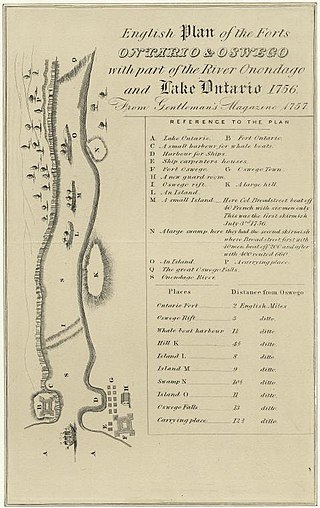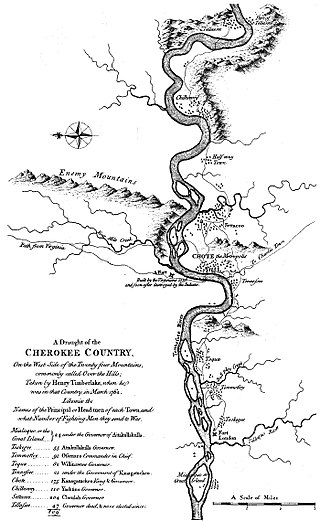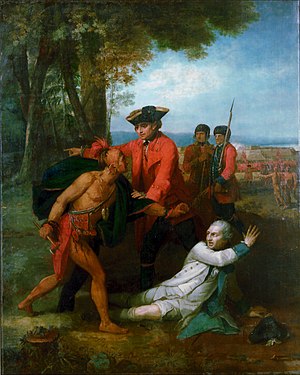
The French and Indian War (1754–1763) was a theater of the Seven Years' War, which pitted the North American colonies of the British Empire against those of the French, each side being supported by various Native American tribes. At the start of the war, the French colonies had a population of roughly 60,000 settlers, compared with 2 million in the British colonies. The outnumbered French particularly depended on their native allies.

The Battle of Carillon, also known as the 1758 Battle of Ticonderoga, was fought on July 8, 1758, during the French and Indian War. It was fought near Fort Carillon on the shore of Lake Champlain in the frontier area between the British colony of New York and the French colony of New France.

Edward Braddock was a British officer and commander-in-chief for the Thirteen Colonies during the start of the French and Indian War (1754–1763), the North American front of what is known in Europe and Canada as the Seven Years' War (1756–1763). He is generally best remembered for his command of a disastrous expedition against the French-occupied Ohio River Valley in 1755; he was killed in the effort.

The Braddock expedition, also called Braddock's campaign or Braddock's Defeat, was a British military expedition which attempted to capture Fort Duquesne from the French in the summer of 1755, during the French and Indian War of 1754 to 1763. The British troops suffered defeat at the Battle of the Monongahela on July 9, 1755, and the survivors retreated. The expedition takes its name from General Edward Braddock (1695–1755), who led the British forces and died in the effort. Braddock's defeat was a major setback for the British in the early stages of the war with France; John Mack Faragher characterises it as one of the most disastrous defeats for the British in the 18th century.

Fort Carillon, presently known as Fort Ticonderoga, was constructed by Pierre de Rigaud de Vaudreuil, Governor of New France, to protect Lake Champlain from a British invasion. Situated on the lake some 15 miles (24 km) south of Fort Saint Frédéric, it was built to prevent an attack on Canada and slow the advance of the enemy long enough for reinforcements to arrive.

The Battle of the Thames, also known as the Battle of Moraviantown, was an American victory in the War of 1812 against Tecumseh's Confederacy and their British allies. It took place on October 5, 1813, in Upper Canada, near Chatham. The British lost control of Southwestern Ontario as a result of the battle; Tecumseh was killed, and his confederacy largely fell apart.

Fort William Henry was a British fort at the southern end of Lake George, in the province of New York. The fort's construction was ordered by Sir William Johnson in September 1755, during the French and Indian War, as a staging ground for attacks against the French position at Fort St. Frédéric. It was part of a chain of British and French forts along the important inland waterway from New York City to Montreal, and occupied a key forward location on the frontier between New York and New France. In 1757, the French general Louis-Joseph de Montcalm conducted a successful siege that forced the British to surrender. The Huron warriors who accompanied the French army subsequently killed many of the British prisoners. The siege and massacre were portrayed in James Fenimore Cooper's novel The Last of the Mohicans.

The 1759 Battle of Ticonderoga was a minor confrontation at Fort Carillon on July 26 and 27, 1759, during the French and Indian War. A British military force of more than 11,000 men under the command of General Sir Jeffery Amherst moved artillery to high ground overlooking the fort, which was defended by a garrison of 400 Frenchmen under the command of Brigadier General François-Charles de Bourlamaque.
Jean Erdman, Baron Dieskau or Jean-Armand Dieskau, Baron de Dieskau or Ludwig August von Dieskau was a German-born soldier remembered mostly as a French general and commander in America for a part of the French and Indian War.

Rogers' Rangers was a company of soldiers from the Province of New Hampshire raised by Major Robert Rogers and attached to the British Army during the Seven Years' War. The unit was quickly adopted into the British army as an independent ranger company. Robert Rogers trained and commanded the rapidly deployed light infantry force, which was tasked mainly with reconnaissance as well as conducting special operations against distant targets. Their tactics were built on earlier colonial precedents and were codified for the first time by Rogers as his 28 "Rules of Ranging". The tactics proved remarkably effective, so much so that the initial company was expanded into a ranging corps of more than a dozen companies. The ranger corps became the chief scouting arm of British Crown forces by the late 1750s. The British forces in America valued Rogers' Rangers for their ability to gather intelligence about the enemy. They were disbanded in 1761.

The Battle of Fort Oswego was one in a series of early French victories in the North American theatre of the Seven Years' War won in spite of New France's military vulnerability. During the week of August 10, 1756, a force of regulars and Canadian militia under General Montcalm captured and occupied the British fortifications at Fort Oswego, located at the site of present-day Oswego, New York.

The siege of Fort William Henry was conducted by a French and Indian force led by Louis-Joseph de Montcalm against the British-held Fort William Henry. This fort, located at the southern end of Lake George, on the frontier between the British Province of New York and the French Province of Canada, was garrisoned by a poorly supported force of British regulars and provincial militia led by Lieutenant Colonel George Monro.

The Battle of Fort Duquesne was a British assault on the eponymous French fort that was repulsed with heavy British losses on 14 September 1758, during the French and Indian War.
The New Hampshire Provincial Regiment was a provincial military regiment made up of men from the New Hampshire Militia during the French and Indian War for service with the British Army in North America. It was first formed in 1754 with the start of hostilities with France.

The 1758 Battle on Snowshoes occurred on March 13, 1758, during the French and Indian War. It was fought by members of British Ranger companies led by Robert Rogers against French troops and Indians allied to France. The battle took place near Lake George, now in northern New York, but then in the frontier area between the British province of New York and the French province of Canada. The battle was given its name because the British combatants were wearing snowshoes.

The 1757 Battle on Snowshoes was a skirmish fought between Rogers' Rangers and Canadien and Indian troops during the French and Indian War on January 21, 1757. The battle was given this name because the British combatants wore snowshoes.

General Johnson Saving a Wounded French Officer from the Tomahawk of a North American Indian is a painting by the British-American artist Benjamin West, completed between 1764 and 1768. It depicts a scene during the French and Indian War, and was painted a few years after the event depicted in the painting, and is now in the collection of Derby Museum and Art Gallery.

The Battle of Echoee, or Etchoe Pass, was a battle on June 27, 1760 during the French and Indian War, between the British and colonial force under Archibald Montgomerie and a force of Cherokee warriors under Seroweh. It took place near the present-day municipality of Otto, in Macon County, North Carolina.
The Burke's Rangers was a company of provincial volunteers organized and led by Major John Burke in Massachusetts just before the French and Indian War. Burke was widely noted for his skill and daring in Indian warfare, and frequently served in campaigns against the Indians. Burke was initially commissioned as an ensign by Governor William Shirley and subsequently commissioned a lieutenant, then a captain. Toward the close of the French and Indian war, in 1760, he was commissioned a major by Governor Thomas Pownall.
William Eyre was an officer in the British Army during the French and Indian Wars.























